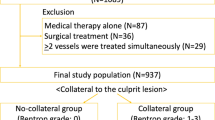Abstract
Background
It is generally believed that there is a beneficial effect of collaterals on death and re-infarction statistics in patients with coronary artery disease (CAD) but studies to date are small and inconsistent.
Objective
To meta-analyse the studies published in this field in order to obtain more powerful information.
Methods
We searched Medline and major journals (2000 to 2011) for studies evaluating the effect of coronary collaterals on mortality. Publication bias, lack of heterogeneity, and lack of robustness were assessed using the standard procedures for such purposes.
Results
A total of 10 studies describing mortality, enrolling 6791 participants, were included in this analysis. In patients with collateralisation a significant relation with reduced mortality was seen compared with those without collateralisation, at an odds ratio of 0.47, p < 0.0001, and a reduction in deaths and re-infarctions at 0.54, p < 0.0001. Some publication bias, some heterogeneity and some lack of robustness were demonstrated. A meta-regression with the odds ratios of the presence of traditional atherosclerotic risk factors as predictors and the odds ratios of mortality and the composite deaths and re-infarctions as outcome showed no relationships.
Conclusions
In CAD patients from the post-percutaneous coronary intervention era the presence of collaterals reduced mortality by 0.47 (p < 0.0001) and deaths and re-infarctions by 0.54 (p < 0.0001). Furthermore, in the present meta-data, the atherosclerotic risk factors were no more present in patients with collaterals than they were in those without.

Similar content being viewed by others
References
Sorajja P, Gersh BJ, Mehran R, et al. Impact of collateral flow on myocardial reperfusion and infarct size in patients undergoing primary angioplasty for acute myocardial infarction. Am Heart J. 2007;154(2):379–84.
Meier P, Hemingway H, Lansky AJ, et al. The impact of the coronary collateral circulation on mortality: a meta-analysis. Eur Heart J. 2012;33(5):614–21.
Bufe A, Haltern G, Dinh W, et al. Recanalisation of coronary chronic total occlusions with new techniques including the retrograde approach via collaterals. Neth Heart J. 2011;19(4):162–7.
Rasoul S, Dambrink JH, Breeman A, et al. The relation between myocardial blush grade and myocardial contrast echocardiography: which one is a better predictor of myocardial damage? Neth Heart J. 2010;18(1):25–30.
Scholzel BE, Endeman H, Dewilde W, et al. Cardiac surgery in a patient with essential thrombocythemia: a case report. Neth Heart J. 2010;18(7–8):378–80.
Elsman P, van ’t Hof AW, de Boer MJ, et al. Role of collateral circulation in the acute phase of ST-segment-elevation myocardial infarction treated with primary coronary intervention. Eur Heart J. 2004;25(10):854–8.
Yoon SJ, Ko YG, Kim JS, et al. Impact of coronary artery collaterals on infarct size assessed by serial cardiac magnetic resonance imaging after primary percutaneous coronary intervention in patients with acute myocardial infarction. Coron Artery Dis. 2009;20(7):440–5.
Albertal M, Cura F, Escudero AG, et al. Relationship between collateral circulation and successful myocardial reperfusion in acute myocardial infarction: a subanalysis of the PREMIAR trial. Angiology. 2008;59(5):587–92.
Ilia R, Wolak A, Amit G, et al. Collateral blood flow can predict myocardial blush grade in primary coronary intervention. Catheter Cardiovasc Interv. 2012;80(1):67–70.
Steg PG, Kerner A, Mancini GB, et al. Impact of collateral flow to the occluded infarct-related artery on clinical outcomes in patients with recent myocardial infarction: a report from the randomized occluded artery trial. Circulation. 2010;121(25):2724–30.
Cleophas TJ, Zwinderman AH. Meta-analysis. Circulation. 2007;115(22):2870–5.
Thompson S. Why source of heterogeneity should be investigated. Systematic reviews London: BMJ Publishing Group, London, UK; 1995. p. 48-63.
Regieli JJ, Jukema JW, Nathoe HM, et al. Coronary collaterals improve prognosis in patients with ischemic heart disease. Int J Cardiol. 2009;132(2):257–62.
Turgut O, Yilmaz MB, Yalta K, et al. Prognostic relevance of coronary collateral circulation: clinical and epidemiological implications. Int J Cardiol. 2009;137(3):300–1.
Desch S, de Waha S, Eitel I, et al. Effect of coronary collaterals on long-term prognosis in patients undergoing primary angioplasty for acute ST-elevation myocardial infarction. Am J Cardiol. 2010;106(5):605–11.
Nathoe HM, Koerselman J, Buskens E, et al. Determinants and prognostic significance of collaterals in patients undergoing coronary revascularization. Am J Cardiol. 2006;98(1):31–5.
Meier P, Gloekler S, Zbinden R, et al. Beneficial effect of recruitable collaterals: a 10-year follow-up study in patients with stable coronary artery disease undergoing quantitative collateral measurements. Circulation. 2007;116(9):975–83.
Antoniucci D, Valenti R, Moschi G, et al. Relation between preintervention angiographic evidence of coronary collateral circulation and clinical and angiographic outcomes after primary angioplasty or stenting for acute myocardial infarction. Am J Cardiol. 2002;89(2):121–5.
Monteiro P, Antunes A, Goncalves LM, et al. Long-term clinical impact of coronary-collateral vessels after acute myocardial infarction. Rev Port Cardiol. 2003;22(9):1051–61.
Berry C, Balachandran KP, L’Allier PL, et al. Importance of collateral circulation in coronary heart disease. Eur Heart J. 2007;28(3):278–91.
Seiler C. Collective prognostic relevance. Collateral Circulation of the Heart. London: Springer; 2009.
Kern MJ, Lerman A, Bech JW, et al. Physiological assessment of coronary artery disease in the cardiac catheterization laboratory: a scientific statement from the American Heart Association Committee on Diagnostic and Interventional Cardiac Catheterization, Council on Clinical Cardiology. Circulation. 2006;114(12):1321–41.
Funding
This article was prepared without external sponsoring.
Conflict of interest
No conflicts of interest.
Author information
Authors and Affiliations
Corresponding author
Rights and permissions
About this article
Cite this article
Akin, S., Yetgin, T., Brugts, J.J. et al. Effect of collaterals on deaths and re-infarctions in patients with coronary artery disease: a meta-analysis. Neth Heart J 21, 146–151 (2013). https://doi.org/10.1007/s12471-012-0361-z
Published:
Issue Date:
DOI: https://doi.org/10.1007/s12471-012-0361-z




